
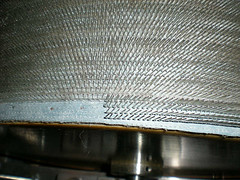 First, this is a closeup of the right edge of my drum carder (right edge as viewed from the front of the carder). See how those three teeth start there? That happens regularly in my carding cloth. The cloth is laid at a slight angle, making it very easy to pull off a continuous roving from a full drum carder.
First, this is a closeup of the right edge of my drum carder (right edge as viewed from the front of the carder). See how those three teeth start there? That happens regularly in my carding cloth. The cloth is laid at a slight angle, making it very easy to pull off a continuous roving from a full drum carder.If I start with a 1/4 inch segment at that edge and rotate the drum as I diz the fiber, it will gradually shift across the drum, following the angle of the cloth, coming off as one long, continuous "batty" roving.
With a carder with the cloth laid on straight, you can still pull roving off, but you have to keep a close eye on it to ensure that you physically keep it shifting to the right as you rotate the drum, since the teeth won't automatically do it for you.
The carder in use here is a PG Super Carder, by the way.
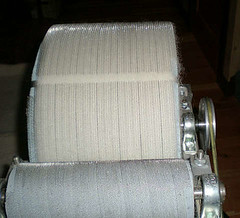 OK, so moving on, the critical first (carding) step -- card your fiber. Here is my drum carder full of Perendale wool. I could take it all off as a batt, but I'd rather have a continuous roving.
OK, so moving on, the critical first (carding) step -- card your fiber. Here is my drum carder full of Perendale wool. I could take it all off as a batt, but I'd rather have a continuous roving.The steps that follow show how I get a 20 foot (I think) length of continuous roving by pulling it off in 1/2 to 1 inch segments around the drum carder, moving from left (seen from the back of the carder -- this picture is the front of the carder) to the right as I diz the roving off.
(for the techies -- technically, this isn't roving. Its closest cousin would be sliver -- carded untwisted fiber. I'm not sure it's exactly that, either, given it's being pulled off a batt. So maybe it's batty roving??)
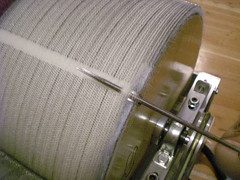 Now, start the roving: using your doffing pin (a knitting needle or sharpened dowel, a handy pen or pencil works in a pinch), lift the first quarter inch only of wool off the drum carder. You'll be pulling up an end of your roving-to-be here, separating it from the left (in this picture) side of the separator, and rotating your drum counter clockwise as you pull the roving off around-and-around the drum.
Now, start the roving: using your doffing pin (a knitting needle or sharpened dowel, a handy pen or pencil works in a pinch), lift the first quarter inch only of wool off the drum carder. You'll be pulling up an end of your roving-to-be here, separating it from the left (in this picture) side of the separator, and rotating your drum counter clockwise as you pull the roving off around-and-around the drum. 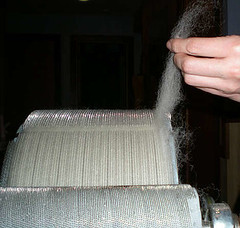 Next, take that first quarter inch and pull up a little in the direction the drum rotates. You'll separate it from the section above the separator so you have an "end" to your roving in your hand.
Next, take that first quarter inch and pull up a little in the direction the drum rotates. You'll separate it from the section above the separator so you have an "end" to your roving in your hand.Don't pull too far -- not more than a bit more than the staple length of your fiber -- so that your segment is still firmly connected to the fiber on the drum carder, except for the part you've lifted off the drum carder.
 Fold over the top inch of the roving you've tugged off the carder to prepare for the next step.
Fold over the top inch of the roving you've tugged off the carder to prepare for the next step. 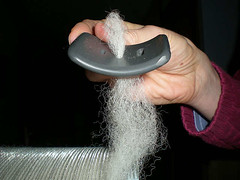 Push the folded over tip through a hole in your diz. I use the "middle" hole in mine; the tiny hole is really hard to pull through, and the big hole lets me pull way too much off. This hole is about 1/8" high and 1/4" wide. (It's the diz that came with my Supercarder for this purpose -- I haven't seen a commercial one like it, though a hole drilled in PVC pipe would be similar.)
Push the folded over tip through a hole in your diz. I use the "middle" hole in mine; the tiny hole is really hard to pull through, and the big hole lets me pull way too much off. This hole is about 1/8" high and 1/4" wide. (It's the diz that came with my Supercarder for this purpose -- I haven't seen a commercial one like it, though a hole drilled in PVC pipe would be similar.)If you don't have a diz, a large hole on a spice jar cap might work, or perhaps take a hole punch to a yogurt lid.
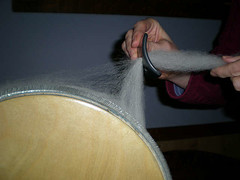 Now we start "dizzing" the fiber off the carder into roving form. Standing behind the drum carder, with the end you put through the diz, start drafting off the carder through the diz. Rotate the carder as you go. I stop tugging on the fiber and give the drum a little nudge as I need to expose the drum to diz off the fiber.
Now we start "dizzing" the fiber off the carder into roving form. Standing behind the drum carder, with the end you put through the diz, start drafting off the carder through the diz. Rotate the carder as you go. I stop tugging on the fiber and give the drum a little nudge as I need to expose the drum to diz off the fiber.If your drum doesn't freely rotate, you'll need to take the band off so that it can (or finagle it some other way).
Never pull out more than the staple length of the fiber at a time. That is to say, never let your hand get more than a staple length away from the drum cloth.
I'm just at maximum extension in this, the first tug through the diz. Any further, and I'd end up with a thin spot in my roving (if I'm lucky) or, more likely, a break.
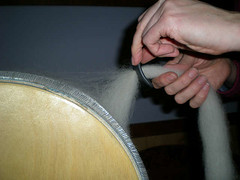 Continue drafting while you rotate the drum. Check (or force it) each time you come to the solid metal band that you are nudging to the right across the teeth to keep the roving continuous.
Continue drafting while you rotate the drum. Check (or force it) each time you come to the solid metal band that you are nudging to the right across the teeth to keep the roving continuous.Remember, try to never draft more than the staple length of the fiber -- this gives a more consistent roving diameter and prevents it from breaking.

The final roving, wound into a ball.
To see the tutorial as a slideshow, see it on flickr!
~~~~
Some more tips for you, from other bloggers:
Abby's How To Clean a Drum Carder
The Redhead's How to turn a batt into roving (off the drum carder)
Rexenne's Drum Carding on YouTube (this link is to part 1, it has 3 parts)
~~~~
My earlier take on this topic: How do you pull roving off a drum carder?
And related posts:
What's the difference between roving and top?
What's the difference between batts and roving?
I washed the fleece, now what?
What are a doffer brush and a burnishing tool used for?
When do I use oils in carding?
To Drumcard, to Handcard, or to Comb?
If you have any comments or questions on this post, please post them on the blog or contact me. Thanks!
